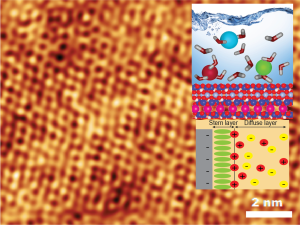
Many interesting dynamic processes happen or are regulated at solid-liquid interfaces, for instance catalysis, corrosion, bio-interactions, self-assembling, etc. Due to the narrow size of such region, an atomistic/molecular approach is required to unravel the structure and time-evolution of these interfacial layers. Nevertheless, a clear picture and, thereby, understanding of double layers is still lacking, at least experimentally and in-operando conditions. In our laboratories, we use high spatial resolution techniques, like AFM, to investigate the molecular forces and, consequently, the nature of electric double layers formed at varying operating conditions (i.e. by varying the potential). To achieve this, we use monocrystalline metal substrates as model system to obtain the highest resolution possible.

